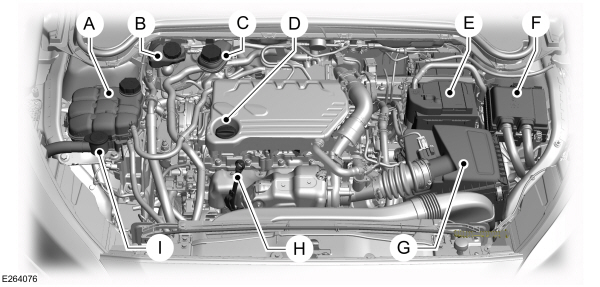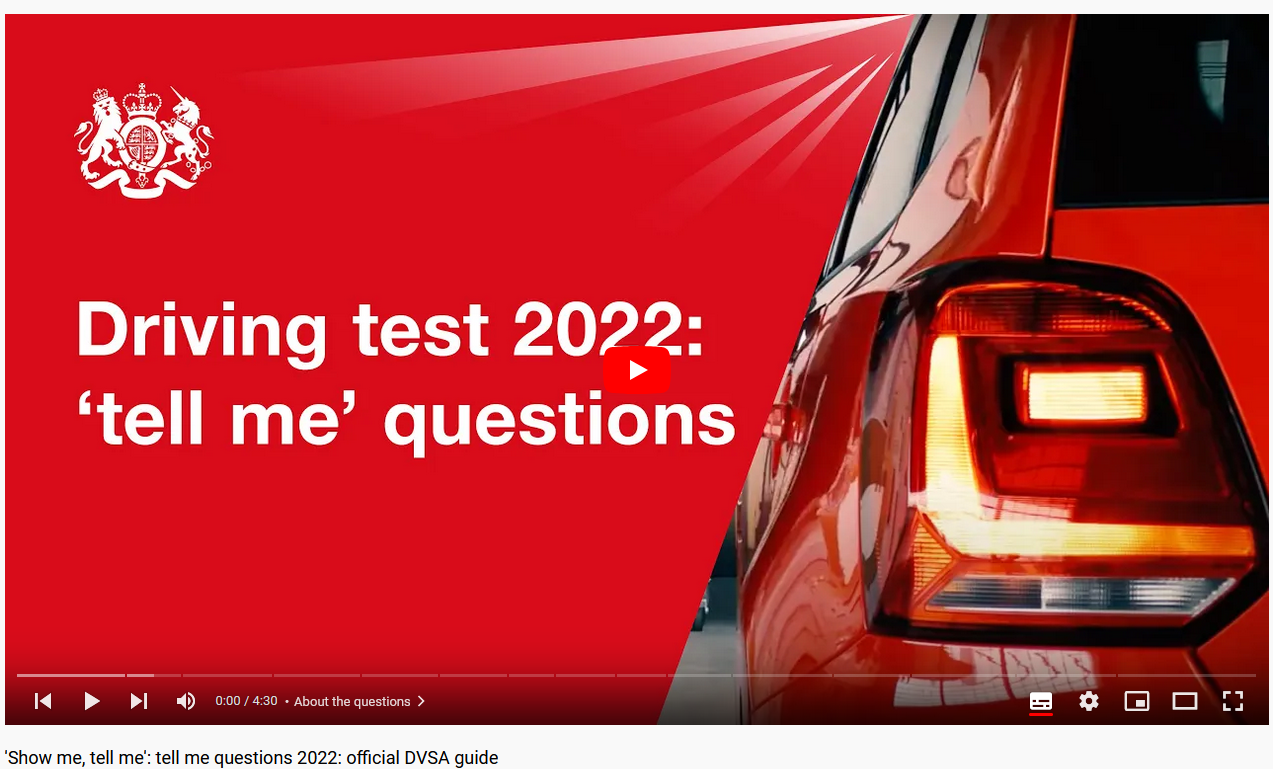Show me Tell me questions.
| |
Questions asked on Category 'B' Tests.
One question will be asked at the Test Centre, another whilst driving.
A![]() Engine coolant reservoir. See
Engine coolant reservoir. See  Engine Coolant Check.
Engine Coolant Check.
B![]() Brake fluid reservoir.See
Brake fluid reservoir.See  Brake Fluid Check.
Brake Fluid Check.
C![]() Engine cooling system overflow reservoir. See
Engine cooling system overflow reservoir. See  Engine Coolant Check.
Engine Coolant Check.
D![]() Engine oil filler cap.See
Engine oil filler cap.See  Engine Oil Check.
Engine Oil Check.
E![]() Battery. See
Battery. See  Changing the 12V Battery.
Changing the 12V Battery.
F![]() Engine compartment fuse box.See
Engine compartment fuse box.See  Fuses.
Fuses.
G![]() Air filter.
Air filter.
H![]() Engine oil dipstick. See
Engine oil dipstick. See  Engine Oil Dipstick.
Engine Oil Dipstick.
I![]() Windshield and rear window washer reservoir. See
Windshield and rear window washer reservoir. See  Washer Fluid Check.
Washer Fluid Check.
 DVSA Show me Tell me Video Link 2022.
DVSA Show me Tell me Video Link 2022.
Tell me how you would:-
1
Open the bonnet, identify where you would check the engine oil level & tell me how you would you check that the engine has sufficient oil.
Identify the dipstick / oil level indicator, describe how to check oil level against maximum /minimum markers. After removing the dipstick, wipe it clean and reinsert it into the holder then check.
2
Open the bonnet, identify the engine coolant header tank and tell me how you would check that the engine has the correct level.
Identify the high/low level markings on the header tank and locate radiator filler cap, ( usually yellow tops ) in the engine bay, explain how to top up, when engine is cold, with coolant ( anti-freeze/water ).
3
Open the bonnet, identify where the brake fluid reservoir is and tell me how you would check that you have a safe level of brake fluid.
Identify the reservoir, check against high/low level markings, ( A low level can be worn pads or a leak in the system, both should be investigated ).
Note:- if brake fluid is spilt on body work, wash away with cold water immediately.
4
Identify where the windscreen washer reservoir is and tell me how you would check the windscreen washer level.
Identify the reservoir and explain how to check the level.
( Refill with water / screen wash if necessary ).
5
Tell me where you would find the information for the recommended tyre pressures for this vehicle and how they should be checked.
You would need to locate the manufacturer's guide / handbook and look up your tyres dimensions, width ( millimetres ), rim diameter ( inches ) and profile ( % ). Using a reliable pressure gauge, check and adjust the pressures when the tyres are cold (front/rear pressures are usually different values); do not forget the spare and remember to refit the valve caps.
6
Tell me how you would check the tyres to ensure that they have sufficient tread depth and their general condition is safe to use on the road.
They should be free of cuts or bulges, at least 1.6 mm of tread depth across the central ¾ breadth of the tyre around the whole circumference,
( Highway Code page 129, see Annex 6 in the Highway Code. ).
7
Tell me how you would check that the brakes are working correctly before starting your journey.
Press the brake pedal when stationary, it should not be spongy or slack. After you have moved off, test your brakes; they should not pull to one side.
8
Tell me how you would check your headlights and tail lights are working correctly before you start your journey.
( No need to exit the vehicle ).
Turn key to switch on the ignition if necessary, then turn on light switch and check lights by walking around the vehicle. ( As it is a 'tell me' question there is no need to exit the vehicle to check the lights ).
9
Tell me how you would make sure your head restraint is correctly adjusted so as to provide the best protection in the event of a collision.
The head restraint should be adjusted so that the centre of the head restraint is at least as high as your eyes or the top of the ears
( see Highway Code rule 97 ) and as close to back of the head as is comfortable.
( N.B. some head restraints are not adjustable ).
10
Tell me how you would know if there was a problem with your anti-lock braking system.
A warning light would illuminate near to the speedometer ( A.B.S. ) if there was a fault with the anti-lock braking system.
11
show me how you would check the parking brake ( handbrake ) for excessive wear; make sure you keep control of the vehicle. [ Not applicable on Electronic Handbrakes ].
Press the footbrake firmly before releasing the handbrake, this will keep the vehicle stationary while you check. Demonstrate by applying the parking ( handbrake ) so that when it is fully applied it secures itself and the vehicle, and is not at the end of its working travel, usually 3 or 4 clicks.
12
Tell me how you would check that the power steering is working before you start your journey.
Before starting your journey two simple checks can be made. Gentle pressure on the steering wheel, maintained while the engine is started, should result in a slight but noticeable movement as the system begins to operate. Alternatively, turning the steering wheel just after moving off will give an immediate indication that the power assistance is operating. If the steering becomes heavy the system may not be working properly.
13
Show me how you would check that the brake lights are working on this vehicle.
I can assist you; if you need to switch on the ignition: please do not start the engine .
Operate the brake pedal, make use of reflections in windows, garage doors, etc, or ask someone to help.
( You may need to turn the key to switch on the ignition, please do not start the engine ).
14
Show me how you would check the direction indicators are working. Either switch on left / right indicator, or hazard warning lights, then check if they are all operating correctly.
You may need to turn on the ignition, please do not start the engine.
If the, warning lights/relay, operate at a much higher rate than normal, this means that a bulb has failed on that side of the vehicle ( normally 60-120 flashes per minute ).
15
Show me how you would check the horn is working.
( Not when the vehicle is stationary, or moving on the road between 11.30 p.m and 7.00 a.m.).
Show me how to:-
The items below are tested on the move.
 Initially it helps to have the windows just open, 10 mm.
Initially it helps to have the windows just open, 10 mm.
 Set all controls, heater, fan and air ducts to the required temperature, air speed and direction to maintain clear windscreens and windows.
Set all controls, heater, fan and air ducts to the required temperature, air speed and direction to maintain clear windscreens and windows. Do not forget the rear demister switch for the back window. Some cars have a switch to heat the front screen. If you have Air Conditioning switch that on.
18
Show me how you would switch on the front & rear fog light(s) and explain when you would use them.
Switch on headlights to dipped beam, turn on front/rear fog lights and explain the warning lights, ( usually orange or green ) on the switch or inside the instrument cluster.
These lights should not be used unless visibility is seriously reduced, i.e. less than 100m; see Highway Code rule 226.
19
Show me how you would switch your headlights on , explain how to switch to dipped beam to main beam and explain how you would know the main beam is on whilst inside the vehicle.
Turn on the head lights.
Operate the switch, usually on the indicator stalk, check that the main beam warning light comes on, the blue one, if it does not then you have lights set to dipped beam.
20
Show me how to open the drivers window, and then close it.
.
This is the last Question.


